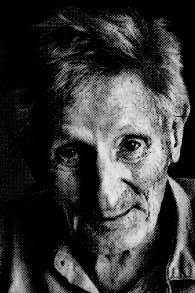| NY Times 10/07/2001 John C Lilly Dies at 86; Led Study of Communication With Dolphins |
|
|
Dr. John C. Lilly a neuroscientist and writer who explored
human consciousness, dolphin communication and the borders of reality
with the showmanship of P. T. Barnum and the infectious zeal of Jacques
YvesCousteau, died on Sept 30 in Los Angeles. He was 86 and lived in
Maui, Hawaii. Combining training in medicine, psychoanalysis and biophysics,
Dr. Lilly carved an eclectic career that shifted between research published
in scientific journals and speculation and self- experimentation codified
mainly in books aimed at fellow students of spirituality and the self. Along with pioneering work probing the electrical activity
in the brain and the behavior of dolphins, he experimented with hallucinogenic
drugs and promoted the recreational use of the isolation tank, an enclosed
saline bath he designed in 1954 for studying sensory deprivation. Dr. Lilly's work inspired two movies, "Day of the
Dolphin," in 1973, in which the Navy turns the animals tnto weapons
and "Altered States" in 1980, tn wh;ch scientists combining
drugs and isolation tanks see reality dangerously unravel. Among his 12 books were "Man and Dolphin"
and "The Mind of the Dolphin," which encouraged a generation
of scientists to study marine mammals and helped arouse public fascination
with dolphins, whose brains are 40 percent larger than those of humans. "Before him, whatever we knew about dolphins came
from performrng animals in oceanaria," said Dr. Diana Reiss a senior
research scientist and expert on dolphin intelligence at the New York
Aquarium in Brooklyn who counts herself among those inspired by his
early writings. "He got people really thinking about big brains
in other body forms _this thing that looked like a fish, but had this
intelligence," she said "He was pretty far-reaching and pretty
far out for a lot of people, but he really did stimulate a lot of research
and ideas." John Cunningham Lilly was born on Jan. 6,1915, in St.
Paul, and by the age of 13 was conducting chemistry experiments in the
basement. He studied physics and biology at the California institute
of Technology, graduating in 1938. He received a medical degree from
the University of Pennsylvania in 1942, then studied biophysics and
psychoanalysis. In World War 11 he did research in the physiology of
high-altitude flying and invented instruments for measuring gas pressure. He spent the rest of the decade studying biophysics
at the University of Pennsylvania, focusing on probing the physical
structures of the brain and becoming absorbed in the pursuit of the
conscious self hidden somewhere in those cerebral folds. He devised pain-free methods for introducing electrodes
deep in an animal's cortex and in 1951 published a paper showing how
he could display patterns of brain electrical activity on a television-like
screen. |
In 1953, he took a post with the Public Health Service Commissioned Officers Corps, where he studied neurophysiology. In 1954, to strip away outside stimuli, again in the hunt for the self, he began experimenting with an isolation tank, using himself and another scientist as the first subjects, suspended for hours in warm salt water. He turned his attention to dolphins in the late 1950's,
when he establishcd the Communication Research Institute on St. Thomas
in the Virgin Islands, a center devoted to fostering human-dolphin communication. In the early 1960's, Dr. Lilly and his co- workers published
several papers showing that dolphins could mimic human speech patterns
with their clicks squeaks and rasping. During this time, he was intro duced to LSD and other ha lucinogcns by colleagues at the National Institutes of Mental Health. He experimented with them in his explorations of his own mind In his book "The Center of the Cyclone,'' published
in 1972, he described the first time he used LSD in an isolation tank.
"I traveled through my brain, watching the neurons and their activities,"
he wrote. He aspired to finding some way to bridge the gaps between
humans and dolphins, although he always acknowledged that their separate
kinds of intelligence were worlds apart. In the process, he steadily
migrated away from mainstream science. By the late 1960's, he no longer worked under government
grants and relied more and more on private sources of financing, as
well as the efforts of a coterie of assistants. Dr. Lilly's marriages to Mary Louise Crouch and Elisabeth
Christine MacRobbie ended in divorce. He later married Antornetta Lena
Oshman, who died in 1986. He is survived by five daughters, Cynthia Lilly Cantwell
of Paradise Calif., Pamela Lilly Krans of Dover N.H., Nina Lilly Castellucio
and Lisa Lilly, both of Malibu Calif. and Barbara Clarke Lilly of Kihe;,
Hawaii; three sons, John C Jr. of Zacatecas, Mexico Charles R of Haiku
Hawaii and Philip Hansen Bailey of Makawao, Hawaii; several grandchildren;
and a brother David M. of St. Paul and Nantucket Mass Late in life, Dr. Lilly maintained a hope that humans
and dolphins would find a common language, laying out the design for
a "future communications laboratory" that would be a floating
living room where humans and dolphins could chat. In a letter to visitors to his Web site (www.johnclilly.com),
he spoke of a time when all killing of whales and dolphins would cease
_ "not from a law being passed, but from each human understanding
innately, that these are ancient, sentient earth residents with tremendous
intelligence and enormous life force. |





